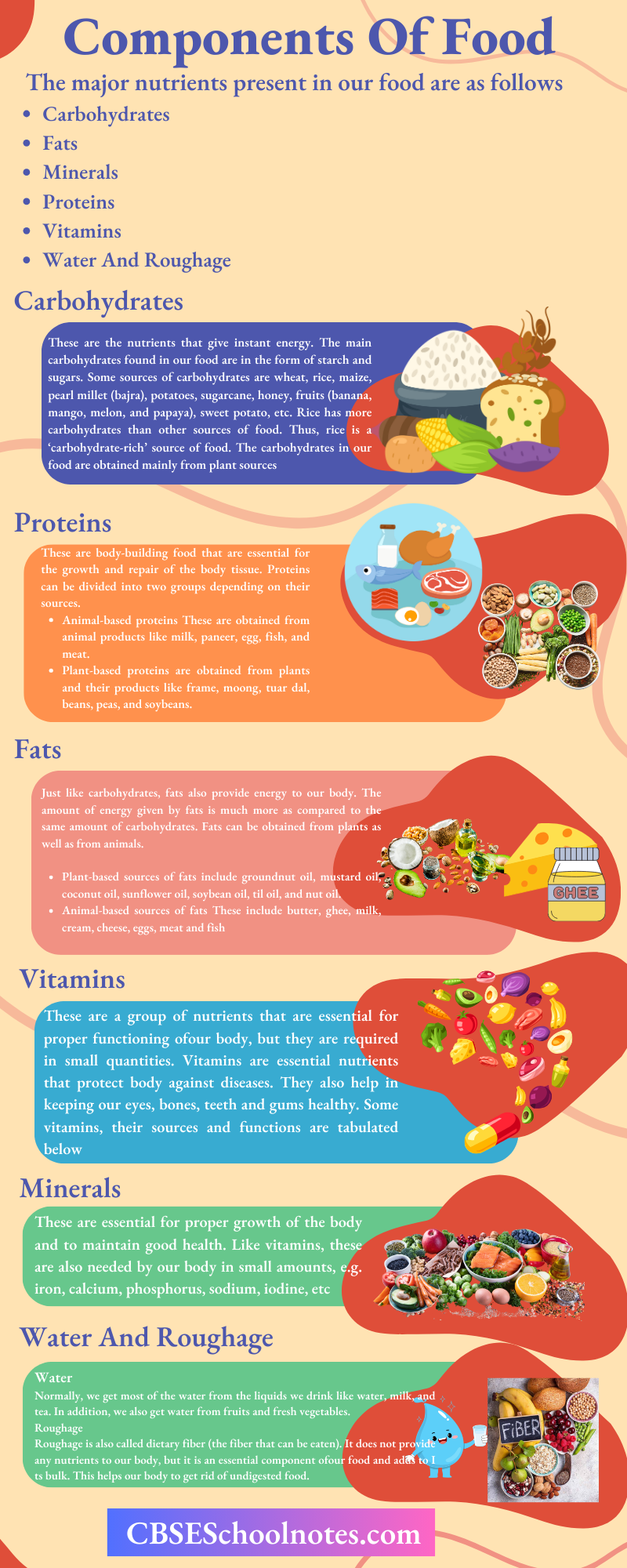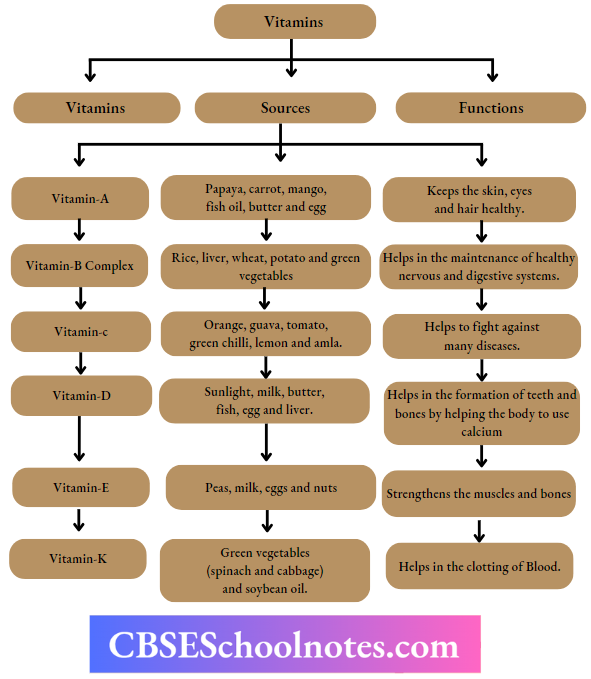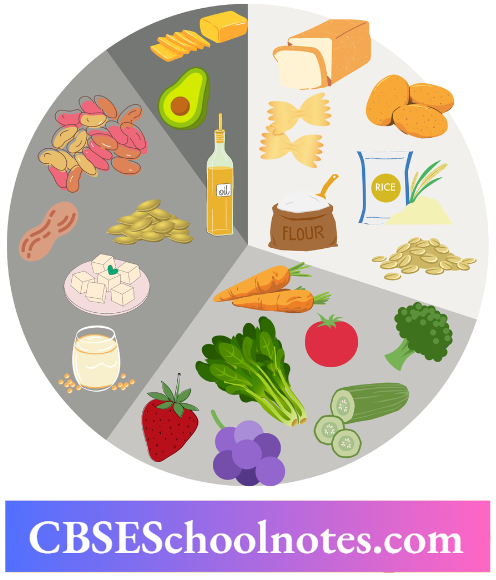Components Of Food
Each food item is usually made up of one or more ingredients, which we get from plants or animals. These ingredients contain some components, which are needed by our body. These components are known as nutrients.
Thus, nutrients are the substances which are required by our body to grow, function properly and stay healthy.

The food items based on the presence of these nutrients can be classified as
- Energy-giving foods These food items are mainly rich in carbohydrates and fats.
- Body-building foods These food items are rich in proteins.
- Protective foods These food items are rich in vitamins and minerals.
Apart from these, our body requires water and roughage to function properly
Read and Learn More Class 6 Science Notes
Science Insight Our nails, hair and skin are made up of keratin protein. The human brain is composed of about 60% fats and it relies on dietary fats for optimal function.
Vitamins
Some vitamins, their sources and their functions are tabulated below.

Minerals

Science Insight Zinc is an essential mineral for our sense of taste and smell. Its deficiency can create problems with the ability to taste and smell food.
Water
Water performs the following functions
- It helps our body to absorb nutrients from food.
- It helps in throwing out waste materials from the body as urine and sweat.
Lack of water in the body causes dehydration. Severe dehydration can even cause death.
Roughage (Dietary Fibre)
It is the fibrous matter present in food that cannot be digested. Roughage is mainly comprised of an indigestible carbohydrate called cellulose, which is present in plants.
Balanced Diet
The total amount of food that a person eats during the entire day is called their diet. A balanced diet is a diet that contains the proper amount of all the nutrients along with a good amount of roughage and water.
It provides the body with all the energy and fulfils various nutrient requirements needed for proper functioning. A balanced diet should include foods that are
- Energy-rich Fats and carbohydrates like butter, rice and chapatis.
- Body-building Proteins like pulses, peas and fish.
- Protective Vitamins, and minerals containing curd, vegetables and fruits.

A balanced diet is not the same for everyone. It depends on age, sex and the type of work that one does. This can be explained by the following examples
- In early childhood, the child grows rapidly. So, he or she needs more proteins.
- Nursing mothers and pregnant women also need more protein to serve the needs of the growing baby.
- A hard worker, i.e. labourer needs more energy, which he can get by eating more fats and carbohydrates
Loss of Nutrients in Food
Eating the right kind of food is not enough. It should also be cooked properly so that its nutrients are not lost. We all know that cooking improves the taste of food and makes it easier to digest. At the same time, cooking also results in the loss of certain nutrients.
So, while cooking we should remember the following important things
- The skins of many vegetables and fruits contain vitamins and minerals.
- If the vegetables and fruits are washed after cutting or peeling them, it may result in the loss of some vitamins.
- Repeated washing of rice and pulses may result in the loss of some vitamins and minerals present in them.
- Many useful proteins and minerals are lost if excess water is used during cooking and is later thrown away.
- Vitamin C gets easily destroyed by heat during cooking.

Deficiency Diseases
The diseases which occur due to the lack of specific nutrients in our diet over a long period are called deficiency diseases. When a person eats food that does not contain a particular nutrient over a long period, then the person may suffer from its deficiency.
- A deficiency of one or more nutrients can cause diseases or disorders in our body.
- Due to the deficiency of one or more nutrients, a person shows the following symptoms
- Deficiency of protein in a person may cause stunted growth, swelling of the face, discolouration of hair, skin disease and diarrhoea.
- Deficiency of both proteins and carbohydrates affects a person’s growth and it may stop completely. Such a person becomes so lean and weak that he/she may not even be able to walk.
- A deficiency of vitamins and minerals may also result in certain diseases,
Some Diseases are caused by the deficiency of vitamins


All deficiency diseases may be prevented by taking a balanced diet
Food is said to be fortified when essential vitamins and minerals are added to common foods like rice, wheat, oil, milk and salt to increase their nutritional value. Given alongside is the logo for fortified foods as per standards by FSSAI.
Science Glossary
- Balanced diet A diet that contains an adequate amount of all nutrients, for healthy functioning of the body.
- Beriberi Disease is caused by a deficiency of vitamin B1. Carbohydrates provide energy to our body. It includes starch and sugar. Energy It is the capacity to do work.
- Fats These are the storehouse of energy in our body. Nutrients The fundamental components of food, that provide nourishment to the body.
- Proteins These are body-building foods that help in repairing and maintaining the body tissues.
- Roughage These are dietary fibre, which forms bulk and helps in the removal of undigested food. Starch is a complex carbohydrate.
- Scurvy Disease is caused by a deficiency of vitamin C. Vitamins and minerals These are protective food that helps our body to fight against diseases.
Activity 1
The presence of carbohydrates in the food
Aim: To test the presence of starch in a food item, for Example potato.
Materials Required: Potato, knife, tincture iodine, water, test tube, dropper and plate.
Procedure:
- Firstly, we will prepare an iodine solution by adding a few drops of tincture iodine to a test tube half-filled with water. Then mix it thoroughly.
- Now, cut a slice of potato with the help of a knife and place it on a plate.
- Add 2 to 3 drops of dilute iodine lypS solution to the potato sample. Testing of starch
Observation: We will observe that the colour of the potato slice changes to a blue-black colour.

Conclusion: The appearance of a blue-black colour confirms the presence of starch in the given food sample, i.e. potato.
Activity 2
We can test the presence of protein in food
Aim: To test the presence of proteins in a food material, Example paneer.
Materials Required: Paneer, copper sulphate, test tube, water, caustic soda, dropper, test tube stand, mortar and pestle.
Procedure:
- Prepare the copper sulphate solution by dissolving
- 2 gram of copper sulphate in 100 mL of water.
- Dissolve 10 grams of caustic soda in 100 mL of water to prepare caustic soda solution.
- Now grind the food material, i.e. paneer into a thin paste, with the help of mortar and pestle. Transfer the paste to a clean test tube.
- Add 10 drops of water to this test tube and shake it well.
- Now, using a dropper add two drops of freshly prepared copper sulphate solution.
- Then add ten drops of caustic soda solution to the test tube and shake it well.
- Place the test tube on the test tube stand for a few minutes.
Observation: After a few minutes, we will observe that the content of the test tube turns violet.
Conclusion: The change of colour in the test tube to violet signifies the presence of protein in the given food material, i.e. paneer.
Activity 3
The presence of fat in the food can be identified by a simple test
Aim: To test the presence of fat in food material, for example, butter.
Materials Required: Butter, brown paper a source of light (bulb), knife.
Procedure:
- Cut a small quantity of food material.
- Put the food material on brown paper and rub over it.
- Now, hold this brown paper towards a source oflight. Observation Under the light will observe a bright, greasy patch on the paper.
Conclusion: The greasy patch confirms the presence of oil, i.e. fat in the food item.
